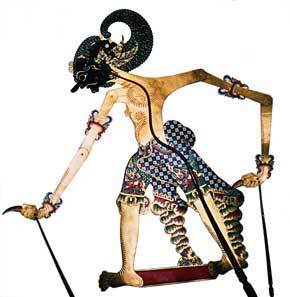
Wayang Kulit, is a type of puppet shadow play performed around the Indomalayan archipelago, tracing its origins to India. It is derived from a Javanese Hindu-Buddhist tradition, where hand-crafted leather puppets depict epic stories of the gods in shadow play. A traditional Gamelan orchestra would accompany the story-telling.
 Definition
DefinitionWayang, in modern Indonesian language, is loosely translated to mean "show" or "performance". Kulit means "skin", a reference to the leather material that the figures are carved out of. Some attribute the word wayang to the Indonesian word bayang which means "shadow". It is also believed that the word wayang has its roots in two earlier words: waya which means "ancestors" and ang which means "a symbol". The term wayang kulit is also used as an idiom to refer to the behind-the-scenes manouverings in the political arena.
 The Puppets
The PuppetsThe puppets come in all sizes, ranging from 25 cm to 75 cm. A basic village set has over a hundred puppets and there are as many as 500 puppets in a palace set. The important characters are usually represented by several versions in a set. The puppets are usually made out of buffalo and goat hide and mounted on bamboo sticks. The best puppets are made from young female water buffalo parchment and the curing can take up to ten years.
 The Show
The ShowIn a shadow puppet play, the puppets are moved behind a cotton or linen screen by a Dalang, or a "Puppetmaster". The Dalang tells the story, interprets characters and voices for each character, producing sound effects with speech and movement. He manipulates all the figures between the lamp and the screen to bring the shadows to life.
Most shadow play is based on two epic stories from India - the Mahabarata and it's sister work, the Ramayana. The Balinese and Javanese have combined the Hindu stories with Buddhist and Muslim ideas mixed with their own folklore.

Shadow play is accompanied by a Gamelan orchestra, an Indonesian orchestra. Many styles of Gamelan instruments exist throughout Indonesia. Each area has a slightly different approach to accompaniment, though most share the same root traditions. Gamelan players respond to the spontaneous timing and direction of the Dalang. The repertoire typically consists of an overture, music for travelling, character pieces, and battle music.
One of Singapore's last Dalangs was Wak Taslim Harjosanajo who died in 1985.
Author:
Endon SallehArticle Source:
http://eresources.nlb.gov.sg/Image Sources:
[url=http://shadowtheatre-ika.blogspot.com/]http://shadowtheatre-ika.blogspot.com/http://sunsetarts.tumblr.com/http://www.indonesiatravelguides.com/http://asiasociety.org/